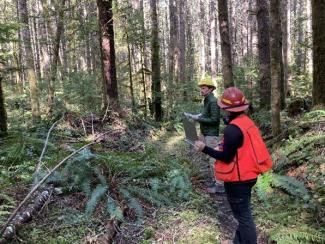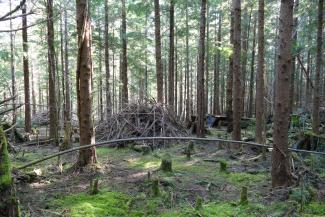The Role of Silviculture in Forest Management

Silviculturists review health of a forested stand at Gifford Pinchot National Forest.
Photo Credit: USDA Forest ServiceThe practice of Silviculture consists of a body of knowledge and techniques that can be applied to shape development of forests to meet whatever objectives are selected, whether the emphasis be on watershed protection, scenic values, ecological restoration, development of wildlife habitat, or wood production.
Silvicultural knowledge and practice have been evolving in the Pacific Northwest for nearly a century.
Most research and management activities to date have focused on two major topics: (1) methods to regenerate older, naturally established forests after fire or timber harvest; and (2) growth and management of young stands.
Today, Forest Service Silviculturists use available knowledge, science as well as ecosystem modeling and other tools to create plans and prescriptions to help forests grow to be as resilient and healthy as possible in the future, while managing for habitat, clean water, recreation, forest product harvest and other priority forest management needs.
Commercial Thinning as a Method to Create Structural Complexity
Scientific research has shown that the old-growth forest’s structural complexity is the key to its biological diversity. As managers work to help forests develop into more complex and resilient ecosystems, commercial thinning is often “prescribed” as a treatment by silviculturists.
These thinning projects are designed to help forested landscapes grow into more complex and resilient ecosystems with more old-growth characteristics.

A forested areas after it has been thinned to improve forest health, within Olympic National Forest.
Photo Credit: USDA Forest Service.Variable-density thinning is the primary commercial thinning method used to accomplish these restoration goals within forested stands. It entails increasing the variation of tree spacing to promote structural complexity, increase plant community diversity, and create a mosaic of habitat conditions. An area treated with variable-density thinning will have both “skips,” untreated areas, and “gaps,” where most trees are removed to create small canopy openings, usually less than a quarter acre.
Studies show that when variable-density thinning is used, thinned stands usually have better developed understories, higher shrub densities, a greater richness of understory plant species, and more plant cover than un-thinned stands. Just as natural processes are variable, a thinning design is site-specific and depends on the characteristics and landscape context of the individual stands.
Commercial thinning projects also provide the national forest with funding that can be used for aquatic restoration, recreational improvements, and other key forest management tasks, while providing jobs and resources to communities.
More information:
- Restoring complexity: second-growth forests and habitat diversity: https://www.fs.usda.gov/pnw/pubs/science-update1.pdf
- Promoting Habitat Complexity in Second – Growth Forests: https://www.fs.usda.gov/pnw/pubs/carey_habitat-complexity.pdf
- Silviculture for Multiple Objectives (1998): https://www.fs.usda.gov/pnw/pubs/pnw_gtr435.pdf


